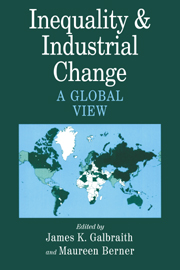Book contents
- Frontmatter
- Contents
- Contributors
- Permissions
- Acknowledgments
- PART I INTRODUCTION TO THEORY AND METHOD
- PART II INEQUALITY, UNEMPLOYMENT, AND INDUSTRIAL CHANGE
- 3 The American Wage Structure: 1920–1947
- 4 Inequality in American Manufacturing Wages, 1920–1998: A Revised Estimate
- 5 Interindustry Wage Structures: New Evidence from the OECD
- 6 Inequality and Unemployment in Europe: The American Cure
- PART III INEQUALITY AND DEVELOPMENT
- PART IV METHODS AND TECHNIQUES
- Data Appendix
- References and Selected Bibliography
- Index
5 - Interindustry Wage Structures: New Evidence from the OECD
Published online by Cambridge University Press: 05 June 2012
- Frontmatter
- Contents
- Contributors
- Permissions
- Acknowledgments
- PART I INTRODUCTION TO THEORY AND METHOD
- PART II INEQUALITY, UNEMPLOYMENT, AND INDUSTRIAL CHANGE
- 3 The American Wage Structure: 1920–1947
- 4 Inequality in American Manufacturing Wages, 1920–1998: A Revised Estimate
- 5 Interindustry Wage Structures: New Evidence from the OECD
- 6 Inequality and Unemployment in Europe: The American Cure
- PART III INEQUALITY AND DEVELOPMENT
- PART IV METHODS AND TECHNIQUES
- Data Appendix
- References and Selected Bibliography
- Index
Summary
This chapter presents an analysis of the evolution of industrial wages in a selection of Organization of Economic Cooperation and Development (OECD) countries, using data drawn from the structural analysis database and a sequence of techniques that apply cluster and discriminant analysis to time series of wage change by industry. The principal finding is that a small number of well-defined groups of industries usually exist whose cross-group differences account for almost all interindustry wage variation. While the specific structure of groups varies according to patterns of natural resources, comparative advantage, and trade union organization within each country, the between-group variation across time usually reflects the movement of macroeconomic variables, some of them internal and other external, such as inflation and exchange rates.
The chaos which seems to prevail in the labor market conceals a pattern of order which can be explained and which sheds light on the influences that determine the inter-industry wage structure of the community.
Slichter (1950:81)Introduction
Since the time of Slichter's (1950) groundbreaking work, the literature on wage structures has often used the concept of rent sharing to explain differences in pay between similar workers in different industries. In a recent article, Blanchflower, Oswald, and Sanfey (1996) reaffirm Slichter and Lester's (1952) analysis, which shows that the distribution of profits to workers accounts for almost a quarter of interindustry wage differentials. And yet, although (as Blanchflower et al. delicately put it) rent sharing is inconsistent with conventional competitive models, the literature continues to rely largely on the competitive framework to interpret changes in the distribution of pay.
- Type
- Chapter
- Information
- Inequality and Industrial ChangeA Global View, pp. 92 - 108Publisher: Cambridge University PressPrint publication year: 2001



